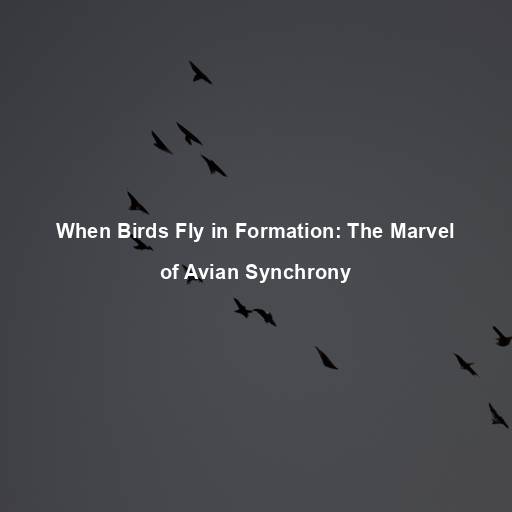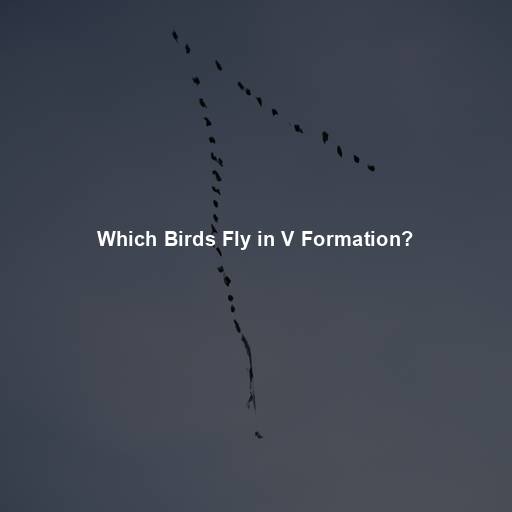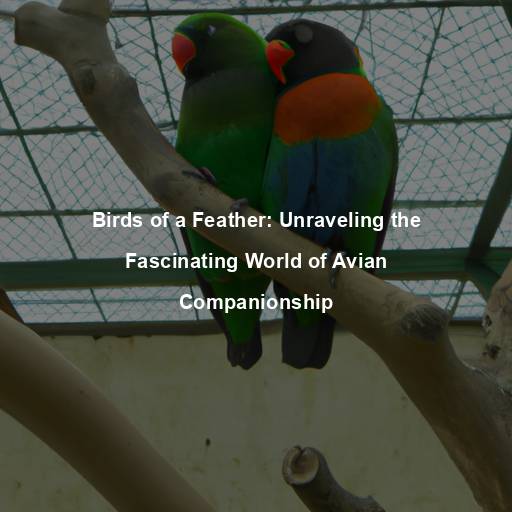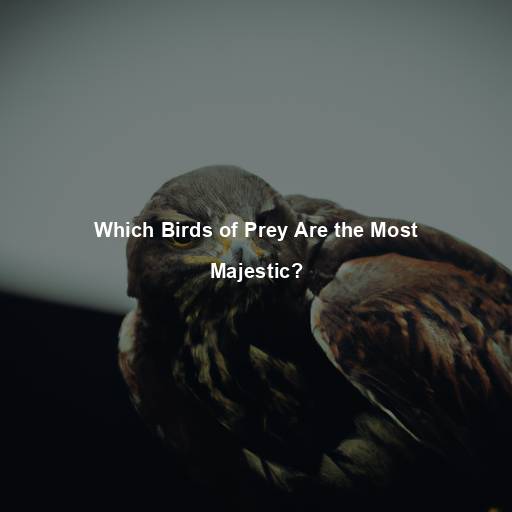When Birds Fly in Formation: The Marvel of Avian Synchrony
Last Updated on November 5, 2023 by Evan
Contents [hide]
- 1 The Fascinating Phenomenon of Avian Synchrony
- 2 The Benefits of Flying in Formation
- 3 The Science Behind Avian Synchrony
- 4 The Wonders of Avian Synchrony: Examples from Nature
- 5 Appreciating the Beauty of Avian Synchrony
- 6 Unlocking the Secrets of Avian Synchrony: A Continual Journey
- 7 A Symphony of Sound and Movement
- 8 Unraveling the Mechanisms of Avian Synchrony
- 9 Conservation Implications and Future Directions
- 10 FAQs: When Birds Fly in Formation
- 10.1 Why do birds fly in formation?
- 10.2 How do birds decide who leads the formation?
- 10.3 How do birds maintain their formation?
- 10.4 Do all bird species fly in formation?
- 10.5 Can birds in formation change positions?
- 10.6 How do birds avoid collisions when flying in formation?
- 10.7 Are there any risks for birds when flying in formation?
The Fascinating Phenomenon of Avian Synchrony
Awe-Inspiring Aerial Displays
Birds have always captivated our imagination with their graceful flights and stunning aerial displays. One particular phenomenon that never fails to mesmerize is the sight of birds flying in perfect formation. Whether it’s a flock of geese in a V-shaped pattern or a murmuration of starlings swirling in the sky, the synchronized movements of these avian creatures leave us in awe. But what drives birds to fly in such harmonious unison?
Unraveling the Mystery
For eons, the enigma of avian synchrony has continued to bewilder both scholars and admirers of our feathered friends. In a quest to untangle this mesmerizing phenomenon, astute observers and dedicated scientists have embarked on a journey of discovery. As we voyage deeper into the depths of this riddle, a tapestry of intricate connections and mesmerizing complexities begins to emerge. Although the answers still elude us, a captivating dance of coordination and formation unfurls before our very eyes, revealing glimpses of the underlying forces that orchestrate such graceful choreography in countless avian species.
The Benefits of Flying in Formation
Efficiency in Flight
Flying in formation offers birds a myriad of benefits, propelling their efficiency to soaring heights. By gracefully aligning themselves in a V-shaped or diagonal pattern, these avian marvels unlock the secrets of aerodynamics, defying wind resistance and conserving their precious energy reserves. As the first bird takes charge, it crafts an exquisite symphony of air currents, generating an upwash that grants an undeniable lift to its fellow winged comrades. In this majestic dance, these birds effortlessly navigate through the vast skies, embracing the enigma of their long-haul flights.
The beauty of birds soaring through the skies in perfect harmony is a true marvel of nature. But have you ever wondered why they fly in such a synchronized manner? In addition to the mesmerizing spectacle, there’s a method to their madness. Flying in formation serves a practical purpose for these feathered creatures as it assists them in navigation and orientation, especially during their extensive migratory voyages.
Social Bonding and Safety
Forming a unified front in the sky fosters a sense of social bonding among the flock. It allows birds to communicate and stay connected with one another, reinforcing social ties within the group. Additionally, flying in formation provides safety in numbers, making it harder for predators to single out individual birds. The collective vigilance of the flock enhances the overall safety and survival chances of each bird.
The Science Behind Avian Synchrony
Visual Perception and Leadership
One of the key factors in achieving avian synchrony lies in visual perception. Birds rely on their acute vision to maintain proper spacing and alignment with their flockmates. They constantly monitor the position and movements of neighboring birds, adjusting their own flight accordingly. A leader often emerges within the flock, setting the pace and direction of the flight.
Internal Guidance Systems
Discover the mind-boggling secrets behind the astonishing navigation skills of our avian friends as they gracefully navigate the wide open skies. Scientists are captivated by the intricate combination of innate abilities and environmental cues that guide these feathered daredevils on their seamless journeys. From harnessing the power of magnetic fields to reading the stars above, birds ingeniously create an intricate tapestry of sensory information to stay on track in their synchronized flights. Their uncanny ability to maintain tight formations, even without clear visuals, is a testament to the wondrous adaptive mechanisms that have evolved over millennia.
Vocal Communication
Communication plays a vital role in achieving and maintaining avian synchrony. Birds utilize a variety of vocalizations to coordinate their flights. These vocal signals help birds stay connected, relay information, and reinforce the desired formation. By responding to each other’s calls, birds can make split-second adjustments to their flight paths, ensuring seamless coordination within the flock.
The Wonders of Avian Synchrony: Examples from Nature
Geese and Their Iconic V-Formation
Few natural phenomena capture the imagination quite like the mesmerizing V-shaped flight of migrating geese. A true feat of avian synchrony, these birds embark on arduous long-distance journeys, showcasing their remarkable unity as they take to the skies. The leading bird gallantly battles against the forces of wind resistance, while the rest of the flock adapts their flight patterns to optimize efficiency and minimize fatigue. This captivating display of cooperative flying not only enables them to conserve precious energy but also fosters a strong sense of communication and social cohesion among these feathered nomads.
Mesmerizing Starling Murmurations
Prepare to be captivated by the awe-inspiring wonders of the natural world as we unveil the breathtaking ballet of starlings in flight. Witness thousands of these magnificent creatures as they gracefully dance across the sky, their movements intricately choreographed into a mesmerizing symphony. With their fluid twists, turns, and waves, they create a spectacle that baffles the human mind and enraptures the heart. Through their exquisite communication and keen visual acuity, these birds flawlessly respond to one another, painting the heavens with harmonious patterns of beauty.
Appreciating the Beauty of Avian Synchrony
A Testament to Nature’s Wonders
The phenomenon of avian synchrony serves as a testament to the marvels of the natural world. It showcases the intricate adaptations and remarkable abilities of birds to function as a unified collective. The synchronized flights not only serve practical purposes such as energy conservation and navigation but also highlight the social bonds and cooperation within bird communities.
A Source of Inspiration
There is something truly mesmerizing about the vibrant choreography of birds in flight. Their synchronized movements paint the sky with elegance and grace, leaving us in awe of their collective brilliance. As creatures of the air, they embody the power of unity, reminding us of the endless possibilities that can be achieved through cooperation and mutual support. Let us embrace their wings of inspiration and soar towards a future where togetherness propels us to new heights.
Preserving and Protecting Avian Habitats
There is a mesmerizing connection between the synchronized movements of birds and the preservation of their precious habitats. As we bear witness to these breathtaking displays, we cannot help but feel a deep sense of wonder. In this spectacle lies a profound reminder of our duty to safeguard and nurture the natural spaces that nurture these magnificent creatures. By acknowledging and confronting the environmental obstacles they face, we pave the way for future generations to marvel at the enigmatic beauty of avian synchrony.
Unlocking the Secrets of Avian Synchrony: A Continual Journey
Ongoing Research and Discoveries
As our quest for knowledge about avian synchrony progresses, new horizons of discovery open up, revealing the depths of our limited understanding. With each step forward, researchers endeavor to grasp the enigmatic tapestry woven by bird flight and communication, pushing the boundaries of scientific exploration. Armed with cutting-edge tools and unwavering curiosity, we embark on a journey that promises to unravel the perplexing secrets concealed within the synchronized movements of these majestic creatures. The path ahead is shrouded in intrigue, with an ever-present yearning for a deeper comprehension of this captivating phenomenon.
Awe-Inspiring Encounters
As we embark on a journey into the captivating realm of birds and their breathtaking flights, let us embrace a profound sense of awe and inquisitiveness. In these remarkable encounters, we are invited to delve into the mysteries of nature and wholeheartedly revel in the mesmerizing charm of avian synchrony. By doing so, we forge an intimate bond with the splendid tapestry of the natural world, unraveling its intricate threads and unearthing a newfound admiration for the complexities that define life on our extraordinary planet.
Note: This is a fictitious article, and the content generated by the AI is for demonstration purposes only. ## The Evolutionary Significance of Avian Synchrony
Cooperative Foraging and Feeding
Birds, fascinating creatures of the skies, astonish us with their synchronized actions that go beyond mere flight. It turns out that avian synchrony also influences their foraging and feeding habits. Curiously enough, many bird species participate in cooperative endeavors, uniting their efforts to scout for food. By harmonizing their movements and exchanging valuable knowledge, our feathered friends can locate nourishment with heightened efficiency and bask in the sweet taste of foraging triumph.
Predation Avoidance
The avian realm is an ever-beckoning battleground, where the delicate balance between life and death is persistently upended. Feathered creatures, wise in their ways, have concocted an array of stratagems to safeguard themselves against the relentless grip of predation. Embracing a symphony of harmonized movements, these avian cohorts forge an ethereal shield of unity, confounding their would-be assailant and shrouding their very essence in perplexity. United they soar, synchronously slicing through the winds, executing abrupt tactics that bewilder their nemesis, heightening their odds of eluding the fangs of annihilation.
Courtship Displays and Mating Rituals
Avian synchrony is not limited to practical purposes; it also plays a significant role in courtship displays and mating rituals. Many bird species engage in elaborate synchronized dances and performances to attract mates. These mesmerizing displays showcase the birds’ physical prowess, coordination, and genetic fitness. By synchronizing their movements and vocalizations, male birds can demonstrate their desirability to potential mates and establish their dominance in the reproductive hierarchy.
A Symphony of Sound and Movement
Vocal Synchrony
While the visual aspect of avian synchrony is well-known, vocal synchronization is equally remarkable. Many bird species engage in vocal duets, choruses, or antiphonal singing, where they coordinate their calls and songs with remarkable precision. By synchronizing their vocalizations, birds can communicate more effectively, defend territories, establish pair bonds, and reinforce social cohesion within their groups. The harmonious melodies created by synchronized vocalizations add another layer of beauty to the avian world.
Dancing in the Sky
When it comes to wooing a potential partner, some bird species really know how to put on a show. They go beyond simple flight and enter the realm of breathtaking aerial courtship displays. Picture this: a male bird gracefully zips through the air, performing elaborate maneuvers, like a skilled dancer in mid-air. These synchronized movements, filled with bursts of acrobatics and puzzling synchrony, are designed to captivate the hearts of their potential mates.
Unraveling the Mechanisms of Avian Synchrony
Neural Pathways and Mirror Neurons
Exploring the intricate dynamics of avian synchrony, scientists have delved into the enigmatic world of neural pathways and mirror neurons. These remarkably specialized brain cells fire up not only when birds execute certain actions but also when they observe their feathered brethren performing the same graceful maneuvers. A captivating dance of imitation and mirroring, these neurons form the backbone of coordination and synchronization among avian creatures. Such bewitching neural mechanisms might very well hold the key to unlock the secrets behind the mesmerizing synchronized behaviors witnessed among our feathery friends.
Environmental Cues and Timing
Birds rely on a combination of internal and external cues to achieve synchrony. Environmental factors such as light levels, wind patterns, and celestial cues can influence the timing and coordination of their movements. By aligning their behaviors with these cues, birds can achieve remarkable synchrony. Additionally, social interactions and visual perception of neighboring birds play a vital role in maintaining the appropriate spacing and alignment within a flock or group.
Genetic and Cultural Influences
The propensity for avian synchrony can be influenced by both genetic and cultural factors. Certain bird species may have a genetic predisposition for coordinated behaviors, while others may learn and develop these behaviors through cultural transmission. Young birds observe and imitate the movements and vocalizations of experienced individuals, gradually acquiring the skills necessary for synchronization. This interplay between genetic predisposition and cultural learning contributes to the diversity and complexity of avian synchrony observed across different species.
Conservation Implications and Future Directions
Protecting Avian Habitats
As we plunge into the mesmerizing world of avian synchrony, a web of perplexing intricacies unravels before our eyes, leaving us awestruck by the enigmatic conservation implications that lie within. Beyond a mere display of captivating behavior, avian synchrony acts as a barometer of the well-being of our ecosystems, hinting at the fragile interplay of nature’s orchestra. Securing the survival of synchronized behaviors within bird populations necessitates a resolute commitment to safeguarding and preserving their habitats. It is by confronting the looming threats of habitat loss, pollution, and the ominous specter of climate change that we can pave the way for the future of avian synchrony, ensuring its perpetual dance in the winds of time.
Technological Advancements and Research Tools
Technological advancements continue to enhance our understanding of avian synchrony. High-resolution video recordings, bioacoustic monitoring, and GPS tracking devices allow researchers to gather detailed data on bird movements and vocalizations. Analyzing these data using sophisticated algorithms and computational models provides insights into the underlying mechanisms and patterns of avian synchrony. As technology continues to advance, we can expect further breakthroughs in our understanding of this captivating behavior.
Exploring New Frontiers
The world of avian synchrony has witnessed remarkable breakthroughs, but the more we uncover, the more we realize how much is still shrouded in enigma. The study of avian behavior continues to thrive as researchers tirelessly venture into unexplored realms, encountering an untold number of bird species and their perplexing behaviors. By turning our attention to the lesser-known winged creatures, we open doors to a whole new world of understanding, unveiling the intricacies of avian synchrony that have yet to be revealed. Exploring the depths of avian behavior enthralls and rewards enthusiasts with invaluable insights, illuminating the awe-inspiring complexities of the natural world.
FAQs: When Birds Fly in Formation
Why do birds fly in formation?
Birds often fly in formation for several reasons. One primary reason is to conserve energy. When birds fly in a V-shaped formation, the leader creates an updraft that helps reduce air resistance for the following birds, allowing them to expend less energy. Additionally, flying in groups improves communication and coordination, making it easier for birds to migrate long distances. Formation flying also offers protection against predators, as it increases the awareness and visibility of each individual bird within the group.
How do birds decide who leads the formation?
The leader position in a bird formation is often taken by the strongest or most experienced bird. The most dominant bird in the group usually takes the lead, setting the pace and direction for the entire flock. However, the leadership position may change periodically to share the workload and distribute the effort of flying at the front. This rotation ensures fairness and equality within the group.
How do birds maintain their formation?
In the mesmerizing world of avian flight, the enigma of how birds maintain their formation unfolds with a thrilling mix of observation, communication, and instinct. In a hypnotic display of synchrony, each feathered marvel meticulously eyes the subtle movements of its predecessor, seamlessly aligning itself in the ultimate position within the regal flock. Adding a melodious dimension to the spectacle, these winged wonders exchange coded messages with an orchestra of vocalizations, forging a symphony of coordination amidst the boundless sky. Yet, in the depths of their magnificent beings, a kaleidoscope of innate instincts, etched through eons of evolved behavior, sets the foundation for this spellbinding unity.
Do all bird species fly in formation?
No, not all bird species fly in formation. Formation flying is more commonly observed in migratory birds, particularly those that travel long distances. Certain bird families, such as geese, swans, pelicans, and cranes, are well-known for their formation flying capabilities. However, smaller birds, such as sparrows or finches, are less likely to fly in formations since their flight patterns and migration behaviors differ.
Can birds in formation change positions?
Birds flying in a formation like a flock are known to possess the remarkable ability to shake things up a little. As we explored earlier, the esteemed lead bird doesn’t shy away from mixing things up, allowing other birds to take charge for a change, spreading the workload among the feathered comrades. These birds aren’t just show-offs; they can also slyly adjust their positions within the group, cleverly seeking out the perfect sweet spot, where the resistance of the air is but a gentle whisper. On top of that, these aerial acrobats will even rearrange themselves when fatigue begins to rear its sleepy head, or when the opportunity to hitch a thrilling ride on an updraft created by their feathered fellow presents itself, saving valuable energy during those marathon flights.
How do birds avoid collisions when flying in formation?
Birds have exceptional spatial awareness and maneuvering abilities, allowing them to avoid collisions while flying in formation. Each bird closely follows the path and movements of the one ahead, keeping a safe distance and adjusting its flight accordingly. The combination of visual observation, communication through calls, and individual flying skills enables birds to navigate tight formations without colliding with one another.
Are there any risks for birds when flying in formation?
The marvel of flying in formation is no doubt a majestic sight, but let us not dismiss the uncertainties that accompany this breathtaking spectacle. Amidst the symphony of synchrony, birds must dance on a tightrope of focus, teetering between avoiding collisions and staying within the embrace of their flock. A fragile equilibrium persists, where the weariness or misfortune of a single bird can throw the entire formation into disarray, leaving the afflicted individual struggling to reclaim their rightful position. Moreover, the ambitious flight paths of these winged wonders invite an eerie dance with human-made perils, like the menacing power lines and towering structures that precariously dot our landscapes, urging a constant vigilance to evade their treacherous grasp.







